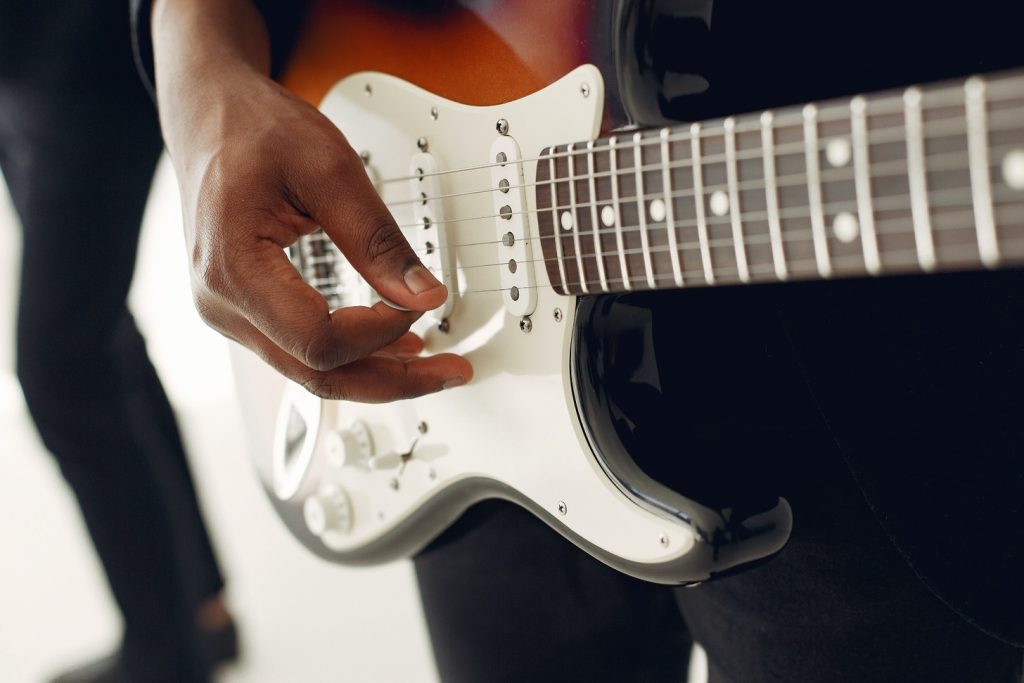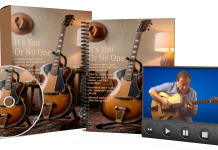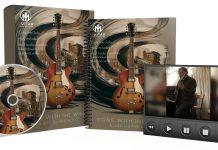This post may contain affiliate links. As an Amazon associate, Google associate as well as associate for other programs, Guitar & Music Institute may earn commissions from qualifying purchases.

Welcome to the world of guitar. In this section, we will dive deep into the different ways that guitar strings are played. Whether you’re a beginner or an experienced guitarist, understanding and mastering various techniques and methods is key to unleashing the full potential of your instrument.
Guitar playing techniques encompass a wide range of styles and approaches, from strumming and fingerpicking to tapping and bending. These techniques allow you to create unique sounds and express your musicality in different ways.
One of the most popular techniques for playing guitar strings is fingerpicking. This method involves using your fingers to pluck the strings individually, allowing for intricate melodies and accompaniment. Fingerpicking styles such as Travis picking, classical fingerstyle, and folk fingerpicking offer their own distinctive patterns and techniques.
Another fundamental technique is alternate picking, which combines downstrokes and upstrokes to play guitar strings. This technique is widely used in various genres, including rock, metal, and jazz. Additionally, tapping techniques involve using both hands to create fast and intricate melodies on the guitar strings.
Throughout this section, we will explore these techniques in detail, providing step-by-step instructions and tips to help you develop your skills. Whether you’re interested in strumming, fingerpicking, or exploring more advanced techniques, this guide has you covered.
We hope that by the end of this section, you’ll feel empowered to experiment with different guitar playing techniques and incorporate them into your musical journey. So let’s get started and discover the fascinating world of guitar string techniques!
Key Takeaways:
- There are various techniques and methods used to play guitar strings, including fingerpicking, alternate picking, and tapping.
- Fingerpicking offers different styles such as Travis picking, classical fingerstyle, and folk fingerpicking, allowing for intricate melodies and accompaniment.
- Alternate picking combines downstrokes and upstrokes and is commonly used in rock, metal, and jazz genres.
- Tapping techniques involve using both hands to create fast and intricate melodies on the guitar strings.
- By mastering these techniques, you can unlock a world of possibilities and express your musicality on the guitar.
Understanding Guitar String Names and Tuning
As a guitarist, one of the first things you need to learn is the names of the guitar strings and how to tune them. Understanding the names and tuning of the guitar strings is crucial for playing chords, melodies, and improvising.
Let’s start with the standard tuning of the guitar strings. The standard tuning is E, A, D, G, B, E. The thickest string, also known as the low E string, is tuned to E. Moving towards the higher strings, we have the A string, tuned to A, the D string, tuned to D, the G string, tuned to G, the B string, tuned to B, and finally, the high E string, which is also tuned to E.
Remembering the string names can sometimes be a challenge, especially for beginners. That’s where mnemonic devices can come in handy. Mnemonic devices are memory aids that help you remember information by associating it with something more familiar. Here’s a popular mnemonic for remembering the standard guitar string names: “Eddie Ate Dynamite, Good Bye Eddie.”
Guitar Strings and Tuning Image
Take a look at the image below to visualize the guitar strings and their standard tuning:
By familiarizing yourself with the guitar string names and standard tuning, you’ll be able to navigate the fretboard with ease and confidently play chords, melodies, and solos on your guitar.
Strumming Techniques for Guitar Strings
Strumming is a fundamental technique for playing guitar strings. It forms the backbone of rhythm guitar playing, allowing you to bring life to chords and create a vibrant groove. In this section, we will explore different strumming techniques that will take your playing to the next level.
Downstrokes: One of the simplest strumming techniques is the downstroke, where you strum the guitar strings in a downward motion using the pick or your thumb. This technique provides a strong and emphasized sound, perfect for accenting the beats in a song.
Upstrokes: On the other hand, upstrokes involve strumming the guitar strings upward. This technique adds a light and airy quality to your playing, creating a contrasting effect to the downstrokes. Upstrokes are commonly used to add finesse and dynamics to your strumming patterns.
Combining Downstrokes and Upstrokes: To create more varied and intricate strumming patterns, you can combine downstrokes and upstrokes. This technique allows you to add rhythmic complexity and a sense of motion to your playing. Experiment with different patterns and rhythms to discover your unique style.
Mastering strumming techniques is essential for any guitarist, whether you’re playing acoustic or electric guitar. To visualize these techniques, take a look at the image below:
Strumming Patterns for Different Musical Styles
Now that you understand the basic strumming techniques, it’s time to apply them to different musical styles. Each genre has its unique strumming patterns and rhythms, giving rise to diverse musical expressions.
For example, in rock and pop music, you’ll often find straightforward patterns with consistent downstrokes and upstrokes on the quarter or eighth note beats. This creates a driving and energetic feel that propels the music forward.
In contrast, folk and country music often employ intricate fingerpicking patterns combined with light strumming for a laid-back and melodic sound. Fingerpicking involves plucking the guitar strings with your fingers rather than using a pick. This technique allows for the individualization of the notes within a chord, enhancing the overall texture of the music.
Lastly, in jazz and blues, you’ll encounter more complex strumming patterns and syncopated rhythms. These genres emphasize improvisation and creative expression, so feel free to experiment with different strumming techniques and create your unique voice.
As you practice and explore different strumming techniques, remember that building a solid foundation takes time and patience. Start with simple patterns and gradually progress to more advanced techniques. Experiment with different rhythms, dynamics, and tempos to develop your own style and musicality.
Fingerpicking Styles for Guitar Strings
If you’re looking to add depth and complexity to your guitar playing, fingerpicking is an essential technique to explore. Fingerpicking allows you to pluck individual strings with your fingers instead of using a pick, creating a rich and melodic sound. In this section, we will dive into different fingerpicking styles, each with its own unique patterns and techniques.
Travis Picking
Travis picking is a fingerpicking style named after the influential country guitarist Merle Travis. This style involves alternating the thumb and fingers to create a syncopated rhythm. The thumb plays the bass notes on the lower strings, while the fingers pluck melody and chordal notes on the higher strings. Travis picking is commonly used in country, folk, and blues music, adding a distinct and lively quality to the guitar.
Classical Fingerstyle
Classical fingerstyle is a technique rooted in classical music and is characterized by precision and control. In this style, each finger has a designated string to pluck, resulting in intricate and complex melodies. Classical fingerstyle requires disciplined finger coordination and is often practiced using arpeggios, scales, and classical compositions. This style is admired for its expressive qualities and is prevalent in classical and flamenco guitar music.
Folk Fingerpicking
Folk fingerpicking encompasses a wide range of techniques and styles developed within traditional and contemporary folk music. Fingerpicking patterns in folk music often emphasize rhythmic strumming and alternating bass notes with melody lines. This style allows for flexibility and interpretation, making it a versatile choice for acoustic guitarists. Whether you’re playing traditional folk songs or modern folk-inspired compositions, fingerpicking adds a unique and intimate touch to your sound.
Alternate Picking Methods for Guitar Strings
When it comes to playing guitar strings, alternate picking is a technique that can greatly enhance your skills and musicality. This technique involves a combination of downstrokes and upstrokes, allowing for fluid and efficient string execution. In this section, we will explore different alternate picking methods, including economy picking, sweep picking, and string skipping.
Economy picking is a technique that combines alternate picking with efficient hand movement. It involves using a downward stroke when transitioning to a lower string and an upward stroke when transitioning to a higher string. This technique maximizes speed and accuracy, making it popular among guitarists in genres such as bluegrass, country, and jazz.
Sweep picking, also known as economy picking on arpeggios, is a technique where the pick glides across the strings in one continuous motion. This technique allows for fast and seamless execution of arpeggios and lends itself well to genres like metal and shred. With practice, you can achieve impressive speed and precision in your sweeping.
String skipping is another alternate picking method that involves intentionally skipping strings while maintaining a consistent picking pattern. This technique adds variety and complexity to your playing, creating unique rhythms and melodic patterns. String skipping is often used in styles like rock and fusion, where musicians strive for intricate and unconventional sounds.
By incorporating alternate picking techniques such as economy picking, sweep picking, and string skipping into your practice routine, you’ll elevate your guitar playing to new heights. These techniques offer versatility, speed, and precision, allowing you to tackle a wide range of musical genres and express yourself on the instrument in exciting ways. Keep honing your alternate picking skills, and watch as your guitar playing reaches new levels of proficiency.

Tapping Techniques for Guitar Strings
Tapping is a technique where the guitarist uses both hands to create sounds on the guitar strings. It’s a remarkable technique that allows for fast and intricate melodic lines. If you want to take your guitar playing to the next level, learning tapping techniques is a must.
One of the most popular tapping techniques is two-handed tapping. This involves using both hands to fret the notes on the guitar neck. By tapping the strings with your picking hand while simultaneously performing hammer-ons and pull-offs with your fretting hand, you can create a seamless and fluid sound.
Hammer-ons and pull-offs are essential elements of tapping. With a hammer-on, you use a finger of your fretting hand to tap a note on the guitar, producing a strong and percussive sound. Pull-offs, on the other hand, involve lifting a finger from a tapped note, allowing the string to sound without plucking it with the picking hand.
Tapping arpeggios are another fascinating aspect of this technique. By tapping out the individual notes of an arpeggio using both hands, you can create complex and stunning musical patterns. Tapping arpeggios are often found in genres like rock, metal, and fusion, adding a dazzling flair to solos and improvisations.
If you’re new to tapping techniques, start by practicing simple patterns and gradually work your way up to more intricate movements. Take inspiration from guitarists like Eddie Van Halen and Stanley Jordan, who are pioneers of this technique. With dedication and practice, you’ll be able to incorporate tapping into your own playing style and create breathtaking musical moments.
So, grab your guitar and start exploring the exciting world of tapping techniques. Unleash your creativity, and let the guitar strings sing with the magic of two-handed tapping, hammer-ons, pull-offs, and tapping arpeggios. With this technique in your arsenal, you’ll be able to add a new dimension to your guitar playing journey.
Slap and Pop Techniques for Guitar Strings
In the realm of funk guitar playing, slap and pop techniques reign supreme. These techniques, also known as slapping and popping, are used to create percussive sounds that add a dynamic and rhythmic element to your guitar playing.
Slap and pop techniques involve striking the strings with your thumb and popping them with your fingers to produce percussive sounds. The slap technique involves using the fleshy part of your thumb to strike the strings near the fretboard, while the pop technique involves plucking or snapping the strings with your fingers.
When executed properly, these techniques can produce a wide range of sounds, from sharp and snappy to deep and punchy. They are often used in funk, soul, and R&B music to add groove and texture to guitar parts.
One of the key aspects of mastering slap and pop techniques is developing a strong sense of timing. It’s important to precisely control the attack and release of each note to create a tight and rhythmic feel. Practice with a metronome or drum track to improve your timing and groove.
Slap and pop techniques can be applied to various guitar strings, including the low E, A, D, G, and even the higher B and E strings. Experiment with different string combinations and techniques to find the right sound for your playing style.
Unlocking the Funk
To achieve that signature funk sound, try combining slap and pop techniques with other embellishments such as slides, hammer-ons, and pull-offs. This fusion of techniques adds flair and complexity to your playing, allowing you to create captivating and infectious grooves.
Keep in mind that slap and pop techniques require practice and patience. Start slowly and gradually increase your speed and accuracy. As you become more proficient, you’ll be able to incorporate these techniques seamlessly into your funk guitar playing.
So, grab your guitar, turn up the funk, and let the percussive sounds of slap and pop techniques elevate your playing to new heights!
Bending and Vibrato Techniques for Guitar Strings
When it comes to adding expression and emotion to your guitar playing, bending and vibrato techniques are your go-to tools. These techniques are widely used in blues guitar playing and are instrumental in creating that signature blues sound.
Bending is the act of pushing or pulling a guitar string to change its pitch. By bending a string, you can add a touch of vocal-like quality to your playing, mimicking the sound of a singer bending a note. There are different types of bends, including half-step bends and full-step bends, each producing a unique sound and feel.
Vibrato, on the other hand, involves oscillating the pitch of a note by quickly and repeatedly bending the string back and forth. This technique adds a shimmering effect to your playing and allows you to sustain notes for longer durations while infusing them with expressive nuances.
By combining bending and vibrato techniques, you can unlock a world of possibilities for creating a bluesy and soulful sound on your guitar. These techniques allow you to inject your playing with emotion, capturing the listener’s attention and making your guitar sing.
Whether you’re playing slow, soulful blues ballads or ripping through fast-paced blues solos, mastering bending and vibrato techniques is essential. With practice and dedication, you can develop your own unique style, elevating your playing and captivating audiences with your expressive guitar skills.
Hybrid Picking Techniques for Guitar Strings
When it comes to expanding your guitar playing skills, hybrid picking is a technique that you should consider adding to your repertoire. This technique combines the use of a pick and fingerstyle playing, allowing for a versatile and dynamic sound. Hybrid picking is particularly popular in country guitar playing, where it adds a distinctive flavor to the music.
By using hybrid picking, you can achieve a fuller and more textured sound compared to using just a pick or fingerstyle alone. The pick provides a strong attack, while the fingers offer precise control and the ability to pluck individual strings or create intricate patterns.
To use hybrid picking, start by holding the pick between your thumb and index finger as you normally would. Then, use your other fingers, such as the middle, ring, and pinky fingers, to pluck the strings. This combination of pick and finger plucking creates a unique blend of tones and allows for greater expressiveness in your playing.
It’s important to practice hybrid picking techniques to develop coordination between your pick and fingers. Start with simple exercises, such as alternating between picking a string with the pick and plucking it with your finger. Gradually increase the complexity of the patterns and incorporate them into your playing.
Combining Pick and Fingerstyle
One popular technique in hybrid picking is to use the pick for playing the lower strings, while relying on your fingers to pluck the higher strings. This allows for a clear and punchy bass line while simultaneously creating melodic phrases or chords on the higher strings. By combining the pick and fingerstyle, you can achieve a balanced and well-rounded sound.
Experiment with different combinations of pick and finger plucking to find what works best for you and the style of music you’re playing. You can also explore using hybrid picking in conjunction with other guitar techniques, such as hammer-ons, pull-offs, and slides, to further enhance your playing.
As you become more proficient in hybrid picking, you’ll discover the wide range of possibilities it offers. Whether you’re playing country, rock, blues, or any other genre, hybrid picking can add depth and creativity to your guitar playing.

So, if you’re looking to expand your guitar playing skills and explore new techniques, give hybrid picking a try. Incorporating a combination of pick and fingerstyle playing can take your playing to the next level, especially in the context of country guitar playing.
Conclusion
Mastering the various guitar playing techniques and guitar string techniques is the key to unlocking a world of musical possibilities. Whether you prefer the rhythmic strumming patterns, the intricate fingerpicking styles, or the mesmerizing tapping and bending techniques, each method offers a unique way to express yourself on the guitar.
Your musical journey begins with a desire to explore and experiment with different guitar playing techniques. Take the time to learn and practice these techniques, allowing yourself to develop your own signature sound. As you become more proficient in mastering guitar strings, you’ll discover new ways to create melodies, express emotions, and captivate audiences with your playing.
Remember, there is no right or wrong way to play the guitar. Each guitarist brings their own style and personality to their playing. So, embrace your individuality and let your creativity soar. Whether you’re a beginner embarking on your musical journey or an experienced player seeking to refine your skills, exploring and mastering guitar playing techniques will continually enrich your musical experience.
FAQ
What are the different techniques used to play guitar strings?
The different techniques used to play guitar strings include strumming, fingerpicking, alternate picking, tapping, slap and pop, bending, vibrato, and hybrid picking.
How do I tune guitar strings and what are their names?
The standard tuning of guitar strings is E, A, D, G, B, E. Mnemonic devices such as “Eddie Ate Dynamite, Good Bye Eddie” can help remember the string names.
What are the strumming techniques for guitar strings?
Strumming techniques for guitar strings include downstrokes, upstrokes, and combinations of both. Mastering these techniques is essential for rhythm guitar playing.
What are some fingerpicking styles for guitar strings?
Some fingerpicking styles for guitar strings include Travis picking, classical fingerstyle, and folk fingerpicking. Each style offers different patterns and techniques for creating melodies and accompanying chords.
What are the alternate picking methods for guitar strings?
Alternate picking methods for guitar strings include economy picking, sweep picking, and string skipping. These techniques are commonly used in various genres such as rock, metal, and jazz.
What are the tapping techniques for guitar strings?
Tapping techniques for guitar strings include two-handed tapping, hammer-ons, pull-offs, and tapping arpeggios. Tapping is often used in soloing and can create fast and intricate melodic lines.
How can I use slap and pop techniques on guitar strings?
Slap and pop techniques can be applied to guitar strings in funk guitar playing to create percussive sounds. These techniques add a dynamic and rhythmic element to the guitar.
How do bending and vibrato techniques enhance guitar playing?
Bending and vibrato techniques add expression and emotion to guitar playing. Half-step and full-step bends, as well as various vibrato techniques, are commonly used in blues guitar playing to enhance phrasing.
What is hybrid picking and how can it be used on guitar strings?
Hybrid picking is a technique that combines pick and fingerstyle playing. It can be used on guitar strings, especially in country guitar playing, to achieve a versatile and dynamic sound.
Source Links
- https://www.toms.co.za/blogs/our-blogs/the-importance-of-string-theory-in-guitar-playing
- https://openhagen.com/blogs/news/the-parts-of-a-guitar
- https://blog.deplike.com/blog/mastering-guitar-notes-for-strings-a-comprehensive-guide/
This post may contain affiliate links. As an Amazon associate, Google associate as well as associate for other programs, Guitar & Music Institute may earn commissions from qualifying purchases.


























